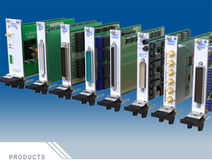Understanding Sensor Simulation in ECU Validation (Part 1 of 6)
Sensors play a pivotal role in ensuring the reliable operation of most transportation options we depend on today. An aircraft is an excellent example that demonstrates the ubiquity of sensors, especially in a simulated environment for ECU validation. Thermocouples monitor engine exhaust temperatures; RTDs measure galley oven temperatures; LVDTs/RVDTs/Resolvers monitor engine thrust reversers, fuel systems, cockpit controls, and flight surface actuators; strain gauges monitor wing deflection, pressure, load, and torque, and accelerometer sensors are also deployed throughout the mainframe.

Figure 1: Different types of sensors and what they measure
Each of these sensors converts physical characteristics into electrical signals that can be used in real-time control systems. For example, thermocouples convert engine exhaust temperatures into low-level voltages that can be amplified and monitored by the aircraft’s ECUs. LVDTs monitoring the thrust reverser position produce an AC voltage signal that feeds a control loop to ensure that the thrust reverser is in the position the pilot has set.
All the information the sensors provide to the control systems ensures that the aircraft operates safely and predictably.

Figure 2: How different sensors are incorporated into an aircraft
The aircraft’s ECUs rely heavily on algorithms within their embedded firmware to process the acquired sensor data, make decisions based on it, and send the required control signals to the relevant internal systems and actuators. During ECU validation and testing, verifying that the units respond safely and reliably to all potential operating conditions—including hardware faults such as open and short circuit wiring—is critical. However, it is not safe nor practical to subject a complete aircraft to every possible environmental scenario to check each ECU’s responses to its complete spectrum of sensor inputs. This is where sensor simulation provides a safe and practical alternative for comprehensive testing, ensuring the engineers feel secure and at ease with the testing process.
The most efficient method to ensure the ECU firmware is functioning as expected—before release to production—is to simulate in a test lab the numerous scenarios that can be experienced in flight. This is typically called putting the ECU ‘in the loop’ and connecting it to test instrumentation that accurately simulates all its sensor inputs. Simulating sensors with utmost precision allows engineers to emulate changes in the aircraft’s physical environment without altering the environment itself. For example, a thermocouple simulation device can be used to emulate a physical thermocouple that is experiencing a change in temperature from ambient to 1000 degrees C without having to create an environment where the temperature is 1000 degrees C. In short, sensor simulation is a highly precise and effective method for validating control algorithms, instilling confidence in their reliability.

Figure 3: A hybrid PXI chassis with various simulation modules
As an industry-standard modular architecture supported by over 60 global test and measurement vendors, PXI has become the preferred platform for hardware-in-the-loop simulation. It allows systems engineers to customize their test beds using a wide choice of commercial off-the-shelf products. In the context of sensor simulation, PXI serves as the backbone, facilitating the replication of real-world sensor outputs. However, since different types of electrical signals are produced depending on the type of sensor being used, there needs to be a purpose-built simulation capability for each sensor type. This is where PXI's versatility truly shines, as it can seamlessly accommodate these diverse requirements, instilling confidence in its adaptability and reassuring engineers of its reliability.
In this blog series, we will explore several different sensors, highlight their unique characteristics, and detail how specific PXI simulators replicate the real-world output signals of each sensor type.
NOTE: This article is part 1 of a 6-part series on sensor simulation we're producing.
Read Part 2: Thermocouple Simulation in ECU Validation
Get notified when we publish our next article by subscribing below.
Learn more about PXI sensor simulation.
RELATED RESOURCES:





